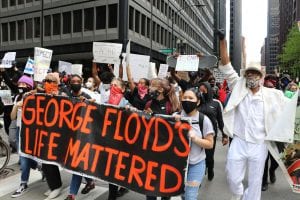 On Monday, May 25, a Minneapolis police officer named Derek Chauvin killed George Floyd by kneeling on his neck for over eight minutes.1 The next day, video of the killing went viral; by the end of the day, large groups had begun protesting in Minneapolis. In the week since, protests have spread to many major cities across the country, and some protests have had destructive consequences.2 It is not always clear who starts the violence and vandalism,3 and there is evidence to suggest that responses from the police are making the violence worse.4 In many ways, the scenes mirror the origins of the Black Lives Matter movement in Ferguson, Missouri, in 2014—another time when police efforts to respond to protests were met with, or perhaps sparked, violence.5
On Monday, May 25, a Minneapolis police officer named Derek Chauvin killed George Floyd by kneeling on his neck for over eight minutes.1 The next day, video of the killing went viral; by the end of the day, large groups had begun protesting in Minneapolis. In the week since, protests have spread to many major cities across the country, and some protests have had destructive consequences.2 It is not always clear who starts the violence and vandalism,3 and there is evidence to suggest that responses from the police are making the violence worse.4 In many ways, the scenes mirror the origins of the Black Lives Matter movement in Ferguson, Missouri, in 2014—another time when police efforts to respond to protests were met with, or perhaps sparked, violence.5
This week, we are offering three blog posts that grapple with the fundamental questions and challenges posed by recent events. On Tuesday, we shared resources and ideas for discussing race and racism with students. Today’s post will explore the protests and the government response to them.
Over the weekend, what began as nonviolent demonstrations in many cities around the United States became sites of property destruction, fires, and escalating responses from police.6 In editorials and commentary in newspapers, on television, and on social media, people are discussing serious questions about the protests. To help your students explore a few of them, we share some questions and resources below.
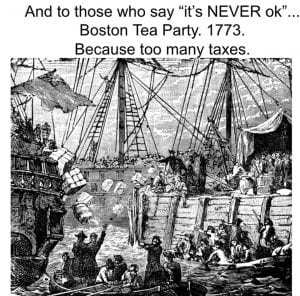
Protests, Social Movements, and Violence
Protest and social change have rarely been as smooth as history textbooks and movies make them seem. In our present context, some argue that the violence near the protests undercuts the power of their message. Others, however, point to a quote from Dr. Martin Luther King, Jr., who said, “I think America must see that riots do not develop out of thin air. Certain conditions continue to exist in our society which must be condemned as vigorously as we condemn riots. But in the final analysis, a riot is the language of the unheard.”
Additionally, those who argue that the destruction of property can be justified frequently point to the violent roots of the United States itself, including the Boston Tea Party, and circulate memes like this one.
While the level of violence in the current protests seems to be decreasing,7 it is still important to consider the role of violence in social movements. Here, we share some resources that might help you have those discussions.
- Fareed Zakaria interviews Nikole Hannah-Jones, creator of the 1619 Project. Jones offers an explanation of the violence and offers historical context.
- In his New York Times column, Ross Douthat argues that violent protests do not work.
- Dylan Scott argues on Vox.com that it is wrong to focus too much on the violent protests, and that people are missing the main story.
- This episode of The Daily podcast from the New York Times offers in-depth reporting on the protests over the weekend.
- In an interview with WBUR, Dr. Marc Lamont Hill argues that protests should be framed as “acts of rebellion,” not riots.
Police and Governments Respond to the Unrest
A second major question facing citizens is how local, state, and national government should respond during this time of protest. President Donald Trump has called for a strong police, and even military, response.8 This has led many Americans to debate the best path forward in responding to the violence that surrounds the protests. Here are some resources that may help you explore government responses to protests with your students:
- Radley Balko explores this question in an article published shortly after the protests in Ferguson in 2014.
- FiveThirtyEight and the The Marshall Project argue that de-escalation by police does more to keep protesters and police safe.
- President Trump explains the role that he sees for government during the protests.
- The June 4 episode of The Daily podcast from the New York Times looks closely at the protests and police actions at the White House.
- This opinion article in The Guardian argues that police are more responsible for the violence than the protesters because of their tactics.
- In this op-ed published in the New York Times, Senator Tom Cotton (R-Ark.) calls for using troops to quell the protests.
- Retired General James Mattis, President Trump’s former secretary of defense, argues in a letter circulated to the media that using the military is not appropriate or constitutional.
We hope that these resources help you examine these complex, challenging, and vital issues with your students. If you have other resources to share with teachers and students, please submit them in the comments below.
Featured Image Credit: Evan Garcia/WTTW News
[1] New York Times: https://www.nytimes.com/article/george-floyd-protests-timeline.html
[2] CNN: https://www.cnn.com/us/live-news/george-floyd-protests-06-01-20/index.html
[3] New York Times: https://www.nytimes.com/2020/05/31/us/george-floyd-protests-white-supremacists-antifa.html
[4] The Guardian: https://www.theguardian.com/commentisfree/2020/jun/01/george-floyd-violent-rioters-america-police-officers
[5] Business Insider: https://www.businessinsider.com/how-the-cops-made-things-worse-in-ferguson-2014-8
[6] Vox: https://www.vox.com/2020/5/30/21275574/george-floyd-protests-minneapolis-detroit
[7] New York Times: https://www.nytimes.com/reuters/2020/06/02/us/02reuters-minneapolis-police-protests-pentagon.html?searchResultPosition=10
[8] Politico: https://www.politico.com/news/2020/06/01/trump-slams-governors-as-weak-crackdown-on-protests-294023
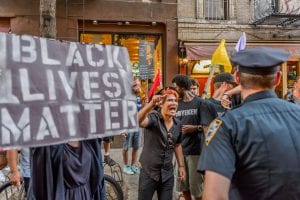
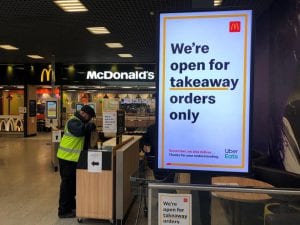 In order to combat the spread of COVID-19, people are making many changes in their habits and routines. Two central recommendations of public health officials are that people remain socially distant1 by staying six or more feet from people and avoiding non-essential trips outside the home, and that people wear masks when in public.2 This has raised questions about the government’s authority to impose social distancing and mask restrictions, as well as the rights and responsibilities of business owners to protect their employees and customers.
In order to combat the spread of COVID-19, people are making many changes in their habits and routines. Two central recommendations of public health officials are that people remain socially distant1 by staying six or more feet from people and avoiding non-essential trips outside the home, and that people wear masks when in public.2 This has raised questions about the government’s authority to impose social distancing and mask restrictions, as well as the rights and responsibilities of business owners to protect their employees and customers.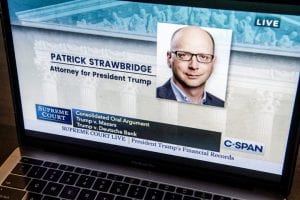 Last week, the Supreme Court heard arguments in two cases involving President Donald Trump’s tax returns and financial records, Trump v. Mazars and Trump v. Deutsche Bank. During the 2016 election, then-candidate Trump broke with tradition and refused to release many of his financial records and tax returns. The president is suing his accountants and banks to prevent them from releasing his personal financial information to Congress. President Trump claims that executive privilege protects him from releasing any of this information to Congress; attorneys for the House of Representatives argue that executive privilege does not apply here.1 So, what is executive privilege and why is it in dispute?
Last week, the Supreme Court heard arguments in two cases involving President Donald Trump’s tax returns and financial records, Trump v. Mazars and Trump v. Deutsche Bank. During the 2016 election, then-candidate Trump broke with tradition and refused to release many of his financial records and tax returns. The president is suing his accountants and banks to prevent them from releasing his personal financial information to Congress. President Trump claims that executive privilege protects him from releasing any of this information to Congress; attorneys for the House of Representatives argue that executive privilege does not apply here.1 So, what is executive privilege and why is it in dispute?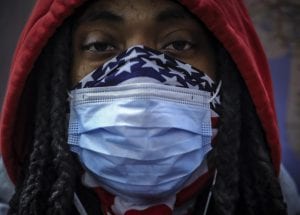 The ongoing COVID-19 pandemic is stressing our healthcare system, our economy, and parents trying to teach their children at home. It is also highlighting significant COVID-19 racial disparities in access to quality health care.
The ongoing COVID-19 pandemic is stressing our healthcare system, our economy, and parents trying to teach their children at home. It is also highlighting significant COVID-19 racial disparities in access to quality health care.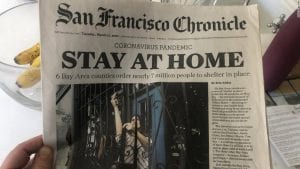 As the COVID-19 2020 news headlines continue to dominate, the American public is facing an onslaught of information about the pandemic. Social and traditional media are covering developments, spreading opinions, and broadcasting statistics about COVID-19. There has been a strong association between coronavirus media coverage and an increase in public attention on the virus itself and in web searches for such terms as “N95” face masks.1 The role of media in the COVID-19 pandemic is significant in shaping public behavior, so as we head into the next phase of the pandemic, journalists and the general public are being forced to consider what role the media should assume moving forward.
As the COVID-19 2020 news headlines continue to dominate, the American public is facing an onslaught of information about the pandemic. Social and traditional media are covering developments, spreading opinions, and broadcasting statistics about COVID-19. There has been a strong association between coronavirus media coverage and an increase in public attention on the virus itself and in web searches for such terms as “N95” face masks.1 The role of media in the COVID-19 pandemic is significant in shaping public behavior, so as we head into the next phase of the pandemic, journalists and the general public are being forced to consider what role the media should assume moving forward.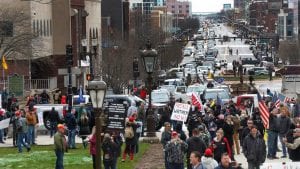 s COVID-19 has spread across the country and the globe, most U.S. states have taken to issuing shelter-in-place orders to help “flatten the curve.” As of April 20, 42 states, the District of Columbia, and Puerto Rico had asked residents to stay at home. However, over the past two weeks, there has been an increase in protests against these orders, with some governors considering reopening their states for the sake of the economy.1
s COVID-19 has spread across the country and the globe, most U.S. states have taken to issuing shelter-in-place orders to help “flatten the curve.” As of April 20, 42 states, the District of Columbia, and Puerto Rico had asked residents to stay at home. However, over the past two weeks, there has been an increase in protests against these orders, with some governors considering reopening their states for the sake of the economy.1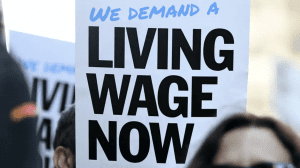 Inequality has been a central issue of the 2020 presidential campaign, with many of the candidates including economic and income equity as major elements of their message.1 The COVID-19 outbreak has also placed economic inequality in the spotlight. While many professionals and white-collar workers are able to work from home, employees in the service industry are either continuing to work or going without pay.2
Inequality has been a central issue of the 2020 presidential campaign, with many of the candidates including economic and income equity as major elements of their message.1 The COVID-19 outbreak has also placed economic inequality in the spotlight. While many professionals and white-collar workers are able to work from home, employees in the service industry are either continuing to work or going without pay.2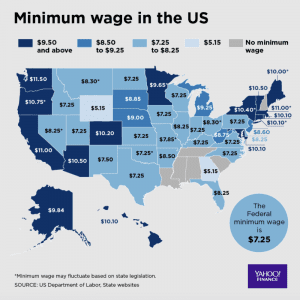
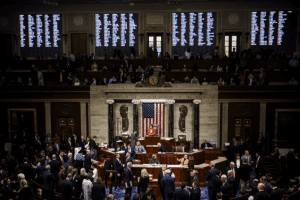 Due to the ongoing COVID-19 pandemic, 42 states—along with Puerto Rico and Washington, D.C.—have issued stay-at-home orders, effectively barring at least 316 million Americans from going out unless absolutely necessary.1 While essential businesses and services remain open, many workers now find themselves working from home. Considering the circumstances, should Congress also be allowed to vote remotely?
Due to the ongoing COVID-19 pandemic, 42 states—along with Puerto Rico and Washington, D.C.—have issued stay-at-home orders, effectively barring at least 316 million Americans from going out unless absolutely necessary.1 While essential businesses and services remain open, many workers now find themselves working from home. Considering the circumstances, should Congress also be allowed to vote remotely?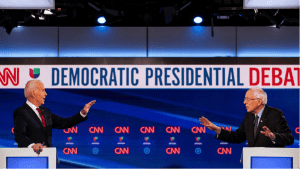 With COVID-19 dominating both the headlines and the realities of everyday life in the United States, it can be hard to remember that we are in the midst of a presidential primary with a general election only seven months away.
With COVID-19 dominating both the headlines and the realities of everyday life in the United States, it can be hard to remember that we are in the midst of a presidential primary with a general election only seven months away.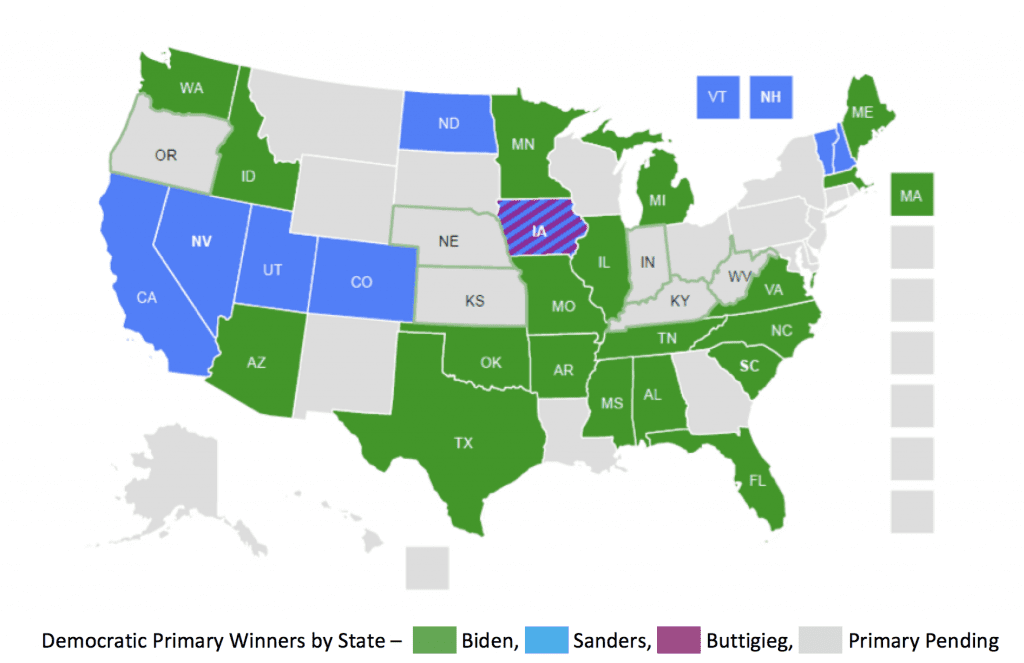 Primary Postponements
Primary Postponements






